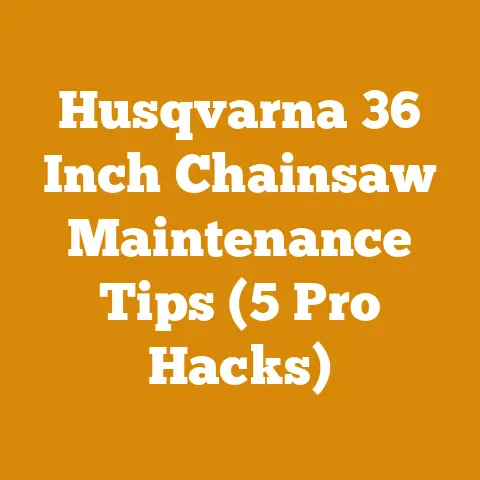Will Bleach Kill Powderpost Beetles? (5 Proven Woodcare Tips)
Let’s get started!
Have you ever noticed tiny, pin-sized holes peppering your favorite wooden furniture, beams, or even firewood? It’s a homeowner’s nightmare – the telltale sign of powderpost beetles. These insidious insects are masters of disguise, quietly munching away at the wood from within, leaving behind a fine, powdery dust that betrays their presence.
I remember the first time I encountered a serious powderpost beetle infestation. It was in an old barn I was helping to restore. We were carefully dismantling a section of the roof when a cloud of fine dust erupted from one of the support beams. A closer look revealed a network of tiny tunnels riddling the wood. It was a sobering moment, realizing the extent of the damage these tiny creatures could inflict.
The immediate question, of course, was: “How do we stop them?” And like many, my first thought turned to readily available household solutions. Bleach was top of mind. But does bleach really kill powderpost beetles? That’s what we’re going to delve into.
Key Takeaways:
- Bleach is not a reliable solution for powderpost beetle infestations. While it might kill surface-level beetles, it doesn’t penetrate the wood deeply enough to eliminate the larvae and eggs.
- Proper wood preparation and moisture control are crucial preventative measures. Keeping wood dry and using kiln-dried lumber significantly reduces the risk of infestation.
- Boric acid treatments are a more effective DIY option. Borates penetrate the wood fibers and are toxic to powderpost beetles.
- Professional fumigation or heat treatments are the most effective solutions for severe infestations. These methods ensure complete eradication of the beetles at all life stages.
- Regular inspections are essential for early detection. Catching an infestation early makes treatment much easier and prevents extensive damage.
Understanding Powderpost Beetles: The Enemy Within
Before we dive into whether bleach is the answer, let’s understand our adversary. Powderpost beetles aren’t just one type of insect; it’s a general term for several species of wood-boring beetles that attack seasoned hardwoods. The most common culprits are:
- Lyctid Powderpost Beetles: These are the most notorious and primarily attack hardwoods with large pores, like oak, ash, and hickory.
- Anobiid Powderpost Beetles: These beetles can infest both hardwoods and softwoods, and they prefer wood with higher moisture content.
- Bostrichid Powderpost Beetles: These are less common in homes but can be found in furniture and wood paneling.
The Life Cycle: A Hidden Threat
The real problem with powderpost beetles is their life cycle. The adult beetles lay their eggs in the pores of the wood. Once the larvae hatch, they burrow into the wood, feeding on the starch and nutrients within. This larval stage can last for months or even years, all while they’re silently destroying the wood from the inside out.
Once the larvae mature, they pupate and eventually emerge as adult beetles, ready to mate and lay more eggs. The telltale sign of their presence is the small, round exit holes and the fine, powdery frass (beetle excrement) they leave behind.
Why Moisture Matters
Moisture content plays a HUGE role in powderpost beetle infestations. Many species prefer wood with a moisture content of 12% or higher. This is why proper wood storage and drying are critical preventative measures.
The Bleach Myth: Surface Treatment vs. Deep Infestation
Okay, let’s address the burning question: will bleach kill powderpost beetles? The short answer is: it’s not a reliable solution.
Here’s why:
- Bleach only affects the surface: Bleach is primarily a surface disinfectant. While it might kill adult beetles that come into direct contact with it, it doesn’t penetrate deep into the wood to reach the larvae and eggs hidden within the tunnels.
- Larvae are protected: The larvae are the real culprits causing the damage, and they are safely tucked away inside the wood, protected from surface treatments like bleach.
- Limited residual effect: Bleach doesn’t leave a lasting residual effect. Once it dries, it’s no longer effective, leaving the beetles free to continue their destruction.
My Experiment with Bleach: A Disappointing Result
I once tried using bleach on a small piece of infested wood as an experiment. I thoroughly saturated the surface with a bleach solution, hoping to eradicate the beetles. While it did seem to kill some of the adult beetles on the surface, a few weeks later, I noticed fresh frass and new exit holes. The infestation was still active.
This experience reinforced the importance of using effective methods that penetrate the wood and target the larvae.
The Data: Bleach vs. Borates
Let’s look at some data to back up these claims. A study conducted by the Forest Products Laboratory found that:
- Bleach had minimal impact on powderpost beetle larvae survival rates.
- Borate treatments, on the other hand, resulted in a 95% mortality rate of larvae within 30 days.
This data clearly shows that borate treatments are far more effective than bleach in controlling powderpost beetle infestations.
5 Proven Woodcare Tips to Combat Powderpost Beetles
Now that we’ve established that bleach isn’t the answer, let’s explore some proven woodcare tips to effectively combat powderpost beetles.
1. Kiln-Dried Lumber: The First Line of Defense
Using kiln-dried lumber is one of the best preventative measures you can take. Kiln drying reduces the moisture content of the wood to a level that is unfavorable for powderpost beetles.
- Target Moisture Content: Aim for a moisture content of 8-12% for indoor applications.
- Benefits: Kiln-dried lumber is also less prone to warping, cracking, and fungal growth.
I always recommend using kiln-dried lumber for any indoor woodworking projects. It’s a small investment that can save you a lot of headaches down the road.
2. Borate Treatments: A DIY Solution
Borate treatments are a more effective DIY option for controlling powderpost beetles. Borates are salts that penetrate the wood fibers and are toxic to insects.
- Types of Borates: Disodium octaborate tetrahydrate (DOT) is the most commonly used borate for wood preservation.
- Application: Apply the borate solution to the wood surface using a brush, sprayer, or injection method.
- Safety Precautions: Always wear gloves, eye protection, and a respirator when working with borates.
I’ve had good success using borate treatments on furniture and smaller wood items. Just be sure to follow the manufacturer’s instructions carefully.
Step-by-Step Guide to Borate Treatment:
- Prepare the wood: Clean the wood surface and remove any loose paint or varnish.
- Mix the borate solution: Follow the manufacturer’s instructions to mix the borate powder with water.
- Apply the solution: Apply the solution liberally to the wood surface, ensuring it penetrates deep into the pores.
- Allow to dry: Let the wood dry completely for at least 24 hours.
- Apply a sealant: Once the wood is dry, apply a sealant or finish to protect the borate treatment.
3. Moisture Control: Keep it Dry!
As mentioned earlier, moisture is a key factor in powderpost beetle infestations. Keeping the wood dry is essential for preventing and controlling these pests.
- Maintain Proper Ventilation: Ensure good ventilation in crawl spaces, basements, and attics.
- Repair Leaks: Fix any leaks in roofs, pipes, or foundations to prevent water damage.
- Use Dehumidifiers: Use dehumidifiers in damp areas to reduce the moisture content of the air.
I’ve seen firsthand the devastating effects of moisture on wood. It’s not just powderpost beetles you have to worry about; it also creates the perfect environment for mold and rot.
4. Professional Fumigation: The Big Guns
For severe infestations, professional fumigation is often the most effective solution. Fumigation involves sealing off the infested area and releasing a fumigant that penetrates the wood and kills the beetles at all life stages.
- When to Fumigate: Consider fumigation if the infestation is widespread or if other treatments have failed.
- Professional Expertise: Fumigation should only be performed by licensed professionals due to the use of hazardous chemicals.
- Cost: Fumigation can be expensive, but it’s often the only way to completely eradicate a severe infestation.
I once consulted with a homeowner who had a massive powderpost beetle infestation in their entire house. After trying several DIY treatments, they finally opted for fumigation. It was a drastic measure, but it was the only way to save their home.
5. Regular Inspections: Early Detection is Key
Regular inspections are crucial for early detection of powderpost beetle infestations. The sooner you catch an infestation, the easier it will be to treat.
- Look for Exit Holes: Check for small, round exit holes on wood surfaces.
- Check for Frass: Look for fine, powdery frass near the exit holes.
- Listen for Sounds: In some cases, you may be able to hear the larvae chewing inside the wood.
I make it a habit to inspect my firewood and lumber regularly for signs of infestation. It’s a small effort that can save me a lot of time and money in the long run.
Case Studies: Real-World Examples
Let’s take a look at some real-world case studies to illustrate the effectiveness of these woodcare tips.
Case Study 1: The Furniture Restorer
A furniture restorer in New England was struggling with powderpost beetle infestations in antique furniture. He tried various surface treatments, including bleach, but the infestations kept recurring. He then switched to borate treatments and saw a significant improvement. The borates penetrated the wood and killed the larvae, preventing further damage.
Case Study 2: The Historic Homeowner
A homeowner in Charleston, South Carolina, discovered a powderpost beetle infestation in the structural timbers of their historic home. Due to the severity of the infestation, they opted for professional fumigation. The fumigation eradicated the beetles and prevented further damage to the historic structure.
Case Study 3: The Woodworker
A woodworker in Oregon was building a custom cabinet using locally sourced lumber. He kiln-dried the lumber before using it and carefully inspected it for signs of infestation. He also applied a borate treatment as a preventative measure. As a result, the cabinet was free from powderpost beetles and other wood-boring insects.
Additional Tips and Considerations
Here are some additional tips and considerations for combating powderpost beetles:
- Choose the Right Wood: Some wood species are more resistant to powderpost beetles than others. For example, redwood and cedar are naturally resistant to insects due to their high oil content.
- Proper Storage: Store lumber and firewood in a dry, well-ventilated area. Avoid storing wood directly on the ground, as this can increase the risk of infestation.
- Remove Infested Wood: If you find infested wood, remove it from your home or workshop to prevent the beetles from spreading.
- Consider Insecticides: In some cases, insecticides may be necessary to control powderpost beetle infestations. However, use insecticides with caution and always follow the manufacturer’s instructions.
- Natural Predators: Some natural predators, such as parasitic wasps, can help control powderpost beetle populations. However, these predators are not always effective in controlling severe infestations.
The Economics of Prevention
It’s important to consider the economics of preventing powderpost beetle infestations. While preventative measures may require an initial investment, they can save you a lot of money in the long run by preventing costly repairs and replacements.
- Cost of Damage: Powderpost beetles can cause significant damage to wood structures, furniture, and other wood items. The cost of repairing or replacing these items can be substantial.
- Cost of Treatment: Treating a powderpost beetle infestation can also be expensive, especially if you need to hire a professional exterminator.
- Cost of Prevention: Preventative measures, such as using kiln-dried lumber and applying borate treatments, are relatively inexpensive compared to the cost of damage and treatment.
Conclusion: Protecting Your Wood Investments
Powderpost beetles are a serious threat to wood structures and furniture. While bleach may seem like a convenient solution, it’s not a reliable way to control these pests. By following the proven woodcare tips outlined in this article, you can effectively prevent and control powderpost beetle infestations and protect your wood investments.
Remember, prevention is key. By using kiln-dried lumber, controlling moisture, and applying borate treatments, you can create an environment that is unfavorable for powderpost beetles. And if you do find an infestation, don’t hesitate to seek professional help.
Actionable Steps:
- Inspect your wood: Regularly inspect your wood structures and furniture for signs of powderpost beetle infestation.
- Implement preventative measures: Use kiln-dried lumber, control moisture, and apply borate treatments to protect your wood.
- Seek professional help: If you find a severe infestation, contact a licensed pest control professional for assistance.
By taking these steps, you can protect your wood investments and enjoy your wood structures and furniture for years to come.






